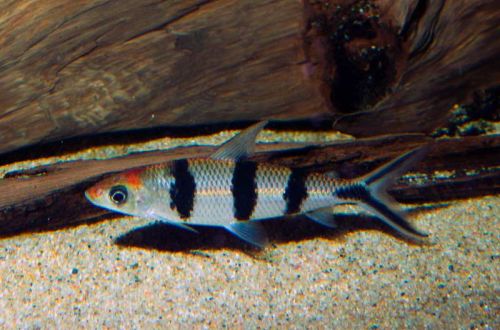
Hemiodus four-banded
Hemiodus quadrilateral, scientific name Hemiodus quadrimaculatus, belongs to the family Hemiodontidae (Chemiodontidae). The fish is native to South America. It occurs in vast expanses of the Amazon, in particular in the basins of the Rio Negro and Trombetas rivers, as well as other smaller river systems of the continent. For example, in Nikeri and Koppenam in Suriname, in Oyapoc in French Guiana, in Araguari in southern Brazil and other places.

It inhabits the upper reaches of rivers, areas with a fast current. A typical biotope is a turbulent river with numerous rapids. The substrate typically consists of sand and rocks, while aquatic vegetation includes hardy species, aquatic mosses and ferns.
Description
Adult individuals reach a length of up to 13 cm. The color is light with yellow tints. There are three black stripes on the body. At the base of the tail there is a dark dot, from which two lines radiate along the sides of the forked caudal fin. The back is dark brown. During the mating season, males may show red marks on their heads.
Behavior and Compatibility
Active energetic fish. Prefers to be in the company of relatives. Gets along with other non-aggressive species of comparable size. You should select fish that can live in similar conditions with a moderate or strong current.
Brief information:
- The volume of the aquarium – from 100 liters.
- Temperature – 23-27°C
- Value pH — 6.0–7.5
- Water hardness – 5–20 dGH
- Substrate type — stony
- Lighting – moderate
- Brackish water – no
- Water movement – moderate or strong
- The size of the fish is up to 13 cm.
- Food – any food
- Temperament – peaceful active fish
- Keeping in a group of 2-3 individuals
Maintenance and care, arrangement of the aquarium
The optimal size of the aquarium for 2-3 fish starts from 100 liters. The design, if possible, should resemble the bottom of a mountain river with substrates of coarse sand, stones, boulders. Additional elements will be driftwood covered with aquatic plants growing on a woody surface, such as anubias, numerous mosses and ferns.
In nature, four-striped Hemiodus often jump out of the water to overcome small rapids of the river, while playing or escaping from predators. For this reason, the aquarium should be fitted with a lid or similar structure to prevent jumping out.
For long-term maintenance, it is necessary to provide clean, oxygen-rich water of medium hardness with pH values in the region of the neutral mark.
Flow can be created by placing a pump or an efficient internal filter.
Food
Feeds on small invertebrates. There are observations that the diet also includes plants and algae. At home, it is permissible to serve artificial feeds rich in protein and containing herbal supplements. It is advisable to use products in the form of jelly, tablets, briquettes fixed at the bottom.
Light floating foods (flakes, small pellets) are not recommended as they will be carried away by the current and enter the filtration system.





